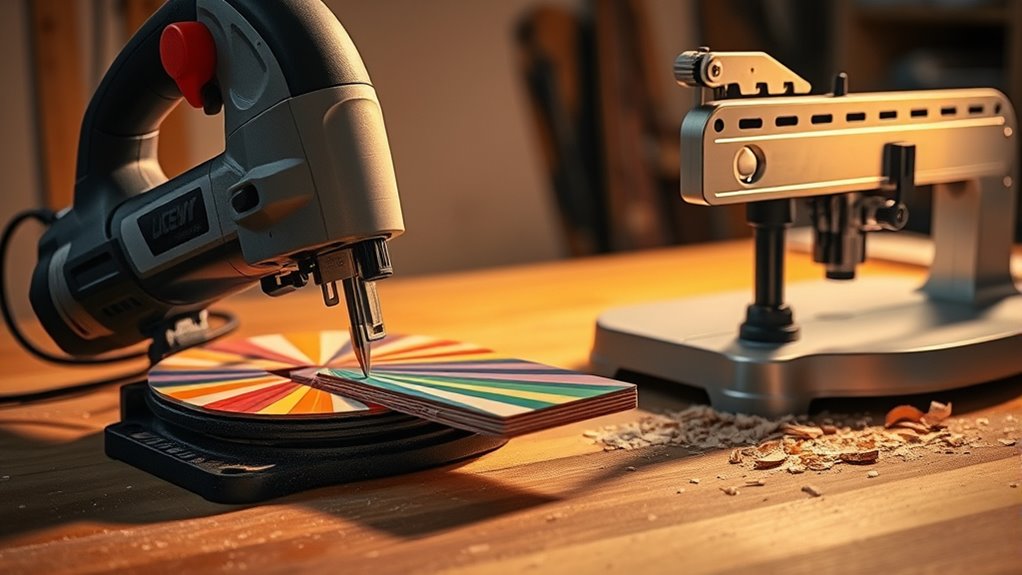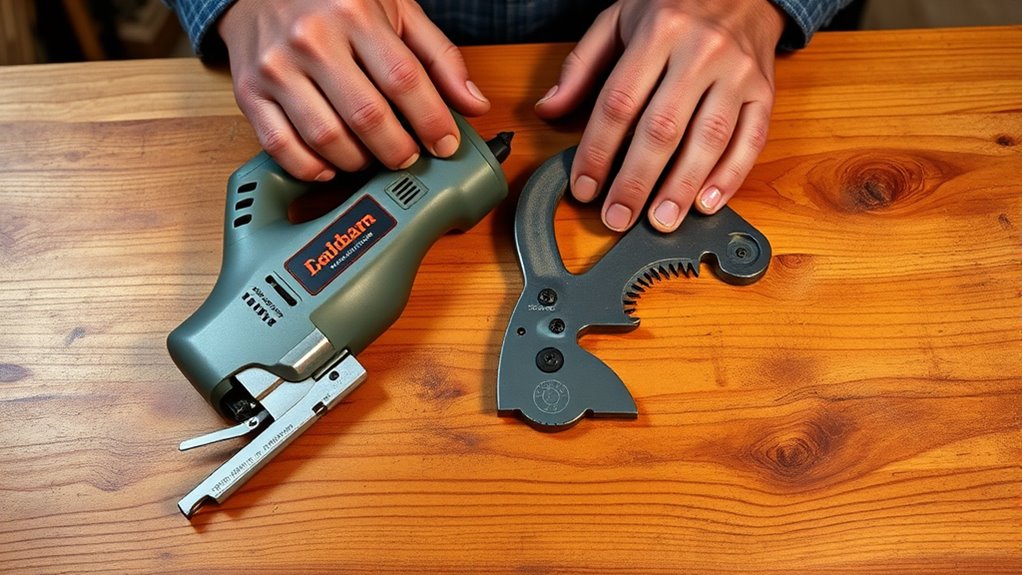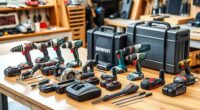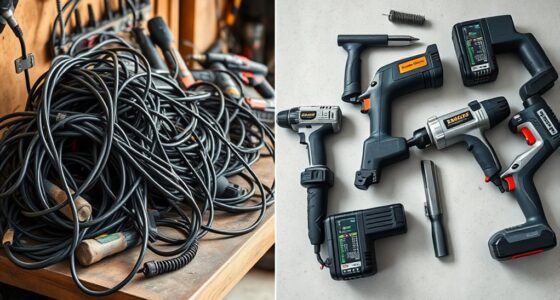When choosing between a jigsaw and a scroll saw, consider the scope of your project. If you need to make rough, large cuts in thicker materials quickly, a jigsaw offers power and versatility. For detailed, intricate designs in delicate materials, a scroll saw provides precision and cleaner cuts. Think about the complexity and scale of your work. Keep exploring to discover which saw best fits your specific needs and projects.
Key Takeaways
- Consider project complexity: use a scroll saw for intricate, detailed cuts; choose a jigsaw for rough or larger cuts.
- Match material thickness: jigsaws handle thicker materials up to 6 inches; scroll saws are best for thinner materials up to 2 inches.
- Evaluate precision needs: scroll saws offer high accuracy for delicate designs; jigsaws are less suited for fine detail work.
- Assess portability and budget: jigsaws are generally less expensive and easier to transport, ideal for on-site projects.
- Determine project scale: for large, rough cuts and remodeling, opt for a jigsaw; for fine craftsmanship and decorative projects, choose a scroll saw.

When deciding between a jigsaw and a scroll saw, understanding their unique features and capabilities is essential. Both tools are versatile for cutting various materials, but they differ notably in design, operation, and suitability for specific projects. One key factor to weigh is blade size, which directly influences the cutting capacity and the types of cuts you can make. Jigsaws typically use blades that range from about 2 to 3 inches in length, allowing for quick blade changes and versatility across different materials. Scroll saw blades are generally much smaller, often less than an inch long, enabling more precise, intricate cuts. The blade size affects the cutting capacity, meaning jigsaws are better suited for rougher, larger cuts, while scroll saws excel at detailed, delicate work.
Your choice depends heavily on the thickness and complexity of the material you’re working with. Jigsaws can handle thicker materials—like plywood or soft metals—up to about 6 inches depending on the blade and model, giving you a broader cutting capacity. Their larger blades and more powerful motors make them ideal for ripping through substantial pieces quickly. Conversely, scroll saws are designed for thinner materials, usually up to 2 inches thick, with a precision that allows you to carve intricate patterns and detailed curves. The smaller, more delicate blades of scroll saws enable tight turns and complex designs that would be difficult or impossible with a jigsaw. Additionally, blade stability in scroll saws contributes to their ability to produce cleaner, more accurate cuts in delicate work.
Another aspect to weigh is the type of projects you’re planning. If you’re working on rough cuts, remodeling, or making straight or curved cuts in large pieces, a jigsaw offers more power and speed. Its blade size and cutting capacity are optimized for these tasks, and it generally costs less and is easier to transport. On the other hand, if your projects require fine detail, such as jewelry boxes, puzzle pieces, or decorative inlays, a scroll saw’s smaller blade and precise cutting capacity make it the clear choice. It allows you to follow intricate patterns with minimal material waste and high accuracy.
Frequently Asked Questions
Which Saw Is Better for Intricate Interior Cuts?
For intricate interior cuts, you need a saw that offers excellent cutting precision and control. A scroll saw excels because its blade speed is adjustable, allowing for delicate, detailed work. Its stability and precision enable you to make tight curves and complex inside cuts. A jigsaw, while versatile, typically isn’t as precise for interior details. So, for intricate interior cuts, a scroll saw is your best choice, providing better control and accuracy.
Can I Use a Jigsaw for Detailed Scroll Work?
You can use a jigsaw for detailed scroll work, but keep in mind its blade versatility and cutting precision are limited compared to a scroll saw. Jigsaws excel at rougher, curved cuts, but for intricate interior designs, a scroll saw provides finer control and cleaner edges. If you want precise, detailed scroll work, a scroll saw is your best choice, but with careful handling, a jigsaw can handle smaller, detailed projects too.
What’s the Maintenance Difference Between the Two Saws?
Imagine your saw as a trusted partner in your workshop. With a scroll saw, you’ll find blade replacement smoother, thanks to its easy-access blade clamps, and dust collection is often built-in, keeping your workspace cleaner. A jigsaw, however, demands more attention for blade changes, and dust collection can be less efficient. Regular maintenance keeps both tools performing well, but the scroll saw’s design makes upkeep a bit more straightforward.
Are There Safety Concerns Unique to Each Saw?
You should always wear safety gear like goggles and gloves when operating either saw. For safety, make certain blade guards are properly in place; a jigsaw’s blade guard protects your hand from the blade’s movement, while a scroll saw’s guard helps prevent accidental contact. Be cautious of kickback with a jigsaw and the fine blades of a scroll saw. Proper safety measures minimize risks and keep you safe during your projects.
How Do the Costs Compare Over Long-Term Use?
Think of your saw as a trusted steed on your woodworking journey. Over time, blade replacement and motor durability determine long-term costs. A scroll saw’s blades wear out slower, reducing replacement costs, but its motor may need more care. A jigsaw’s blades are cheaper but need frequent changes, and its motor endures more strain. Balancing these factors helps you manage expenses as your project horizon expands.
Conclusion
Ultimately, your choice depends on the projects you tackle and your preferences. A jigsaw offers versatility and portability, perfect for quick cuts and irregular shapes. Meanwhile, a scroll saw provides precision and intricate detail, ideal for delicate work. Think of it as choosing between a trusty sword and a laser beam—each has its time and place. Whichever you pick, just remember: even in the age of smartphones, a good saw still rules the workshop.









